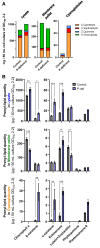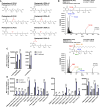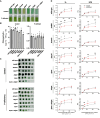Cyanoglobule lipid droplets are a stress-responsive metabolic compartment of cyanobacteria and the progenitor of plant plastoglobules
- PMID: 40403160
- PMCID: PMC12223511
- DOI: 10.1093/plcell/koaf127
Cyanoglobule lipid droplets are a stress-responsive metabolic compartment of cyanobacteria and the progenitor of plant plastoglobules
Abstract
Lipid droplets (LDs) are well integrated into multiple facets of cellular physiology and potentially represent an effective platform for engineering heterologous metabolic pathways. LDs of chloroplasts, known as plastoglobules, mediate stress tolerance through dynamic and reversible changes to morphology and molecular composition. However, the dynamics and functional role(s) of cyanobacterial LDs are almost wholly unknown. Here, we have characterized the morphological behavior and quantitative proteome and lipidome of cyanobacterial LDs of Synechocystis sp. PCC 6803 grown under permissive or phosphorous-deficient media for 7 d. Our results show that cyanobacterial LDs are a metabolically active subcompartment of cyanobacteria with dynamic morphology and composition. The cyanobacterial LD proteome and lipidome are qualitatively similar to those of plant plastoglobules including an enrichment of prenyl lipids and the presence of twelve orthologs of Arabidopsis thaliana plastoglobule proteins. In view of these results, we propose that cyanobacterial LDs be named as cyanoglobules. In addition, we established that various plastoquinone derivatives containing hydroxyl and/or acyl groups on their solanesyl tail or quinone head accumulate in cyanoglobules. Deletion mutants of selected cyanoglobule proteins exhibit impairments in growth, pigmentation, and photosynthesis. Our results collectively support an evolutionary relationship between cyanoglobules and plastoglobules and reveal a possible central role for cyanoglobules in organismal physiology and stress adaptation.
© The Author(s) 2025. Published by Oxford University Press on behalf of American Society of Plant Biologists.
Conflict of interest statement
Conflict of interest statement. None declared.
Figures









Similar articles
-
Evolutionary conservation of acylplastoquinone species from cyanobacteria to eukaryotic photosynthetic organisms of green and red lineages.Front Plant Sci. 2025 Mar 24;16:1569038. doi: 10.3389/fpls.2025.1569038. eCollection 2025. Front Plant Sci. 2025. PMID: 40196435 Free PMC article.
-
The NTPase activity of the double FYVE domain-containing protein 1 regulates lipid droplet metabolism.J Biol Chem. 2023 Feb;299(2):102830. doi: 10.1016/j.jbc.2022.102830. Epub 2022 Dec 24. J Biol Chem. 2023. PMID: 36574842 Free PMC article.
-
The Black Book of Psychotropic Dosing and Monitoring.Psychopharmacol Bull. 2024 Jul 8;54(3):8-59. Psychopharmacol Bull. 2024. PMID: 38993656 Free PMC article. Review.
-
Stigma Management Strategies of Autistic Social Media Users.Autism Adulthood. 2025 May 28;7(3):273-282. doi: 10.1089/aut.2023.0095. eCollection 2025 Jun. Autism Adulthood. 2025. PMID: 40539215
-
Systemic pharmacological treatments for chronic plaque psoriasis: a network meta-analysis.Cochrane Database Syst Rev. 2021 Apr 19;4(4):CD011535. doi: 10.1002/14651858.CD011535.pub4. Cochrane Database Syst Rev. 2021. Update in: Cochrane Database Syst Rev. 2022 May 23;5:CD011535. doi: 10.1002/14651858.CD011535.pub5. PMID: 33871055 Free PMC article. Updated.
References
MeSH terms
Substances
Grants and funding
LinkOut - more resources
Full Text Sources
Research Materials

